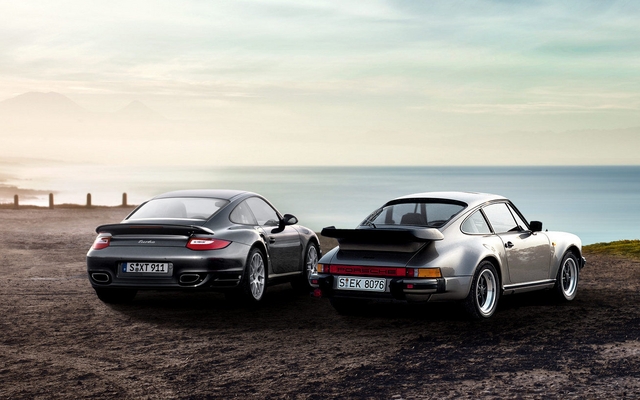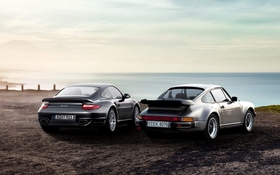The 2010 Porsche 911 Turbo: My Automotive Everest

| Strong points |
|
|---|---|
| Weak points |
|
On the 10th of September, 1944, Lt. William H. Baker, a navigator with the 600th Squadron, 398th Bomber Group, 8th U.S. Air Force, took off from England, destined for Stuttgart, Germany. Flying at 26,000 feet after dropping 6,000 pounds worth of ordinance from his B-17, Lt. Baker took the time to record the moment for posterity with the following journal entry: “Flak was very intense and very accurate – Ship next to us received direct hit – Lost entire belly of ship and went down. – Caught flak for 1 hour, 12 minutes – If war’s nearly over Flak gunners don’t know it – Flak getting worse – Every place you looked saw hundreds of B17’s and B24’s and fires all over. – All of S.W. Germany must have been burning – No Flak holes luckily – Haven’t heard from Bob. – Visual target.
By war’s end, Stuttgart would see the business end of over 142,000 bombs, resulting in 15 million cubic metres of rubble and 39,125 buildings destroyed or damaged. At Kronenstrasse 24, the automotive design consultancy known as Dr. Ing. h. c. F. Porsche GmbH lay crippled by the effects of the Allied occupation; its founder Ferdinand incarcerated on charges of war crimes with the company’s main production facility in Wolfsburg under British command. And at the centre of it all, the one man that would bring fame to the Porsche name: Ferry. Dissatisfied with the automotive offerings available to a relatively wealthy post-war German, Ferry set to work designing the world’s first Porsche sports car and the car that would, after thousands of individual revisions, become the benchmark by which all others are measured: the Porsche 911 Turbo.
It was a daunting thing, really, to look upon a car of this ilk and know that it was to be my responsibility for the coming days. Maybe it was the foreboding disclosure all journalists sign before piloting a Porsche product, perhaps it was how narrow the garage door looked in relation to its widened stance, or maybe it was the years I’d spent pining for this opportunity, but there was something about this car specifically that weighed especially heavy on my mind when the moment finally came to slide the simple, conventional key into the ignition cylinder. That the five minutes prior to this had been spent waving the ignition key around in my right hand like a dropout from Hogwarts School of Witchcraft and Wizardry didn’t help much.
Thankfully, once I’d successfully disarmed my right hand (expelliarmus!) and gotten the conservatively styled key fitted to the ironically leftist ignition, my premonitions of impending scuffs and scrapes were quickly dispelled. Almost as if by magic, what I’d thought to be an impossibly wide, impossibly low supercar was transformed into a compact and agile vehicle perfectly suited to the worst rush hour traffic the lower mainland had to offer. First, there's the visibility. It’s absolutely unparalleled in cars of this variety, and only truly bested by vehicles with removable rooves and folding windshield. Owing much of its outward visibility to a tradition of short dashboards, less-than-rakish windshield angles, and narrow, spidery, A-pillars, the 911 Turbo feels downright airy when compared to its most publicized competitors, the Nissan GTR and Audi R8.
And then, of course, there’s the interior styling. Although I’d be the last one to malign the sublime cabin of Audi’s flagship sports car, and am one of the few that enjoyed the Gran Turismo-infused interior of Nissan’s GTR, there’s something that’s just divinely right about the cockpit of the 911. Trimmed in a very staid shade of chocolately brown, it boasted the expectedly perfect ergonomics I’d heard so much about, but tempered its plethora of modern readouts and switchgear with a healthy supply of simplistic retro styling. Definitively attractive in its own right, the interior’s styling is perhaps the best example of form following function in the automotive world. Every switch is perfectly placed, every readout obvious without being distracting; its everything one needs to go about the task of driving in the most expeditious manner possible. Sure, there’s plenty of luxuries like heated seats and Bluetooth cell phone connectivity, but the interior never advertises it’s modernity, instead content to simply provide the simplest control interfaces possible in the least imposing manner. As a result, it feels like the classic, purposeful, sports cars automotive journalists like myself love to wax on about ad nauseum… with all of the features that we’d most certainly continuously whine about missing if forced to conduct our daily business in anything from the pre-Bluetooth era.
But if the interior is a perfect blend of classic proportions, retro design, and modern amenities, the driving experience is anything but. To truly understand the mentality that results in a car of this ilk, one must once again consider the problem facing Ferry Porsche in the days following his father’s arrest. It’s a very committed person that, faced with a market of substandard products, decides to remedy the problem by building on of their own design, and that mentality has clearly been cultivated amongst the employees at the Porsche headquarters ever since. From the variable geometry turbochargers to the dual clutch gearbox to the very layout of the car itself, Porsche’s engineers gave themselves no quarter, and the result is absolutely, positively stupefying.
All it takes is the slightest of effort to whisk the car past slow moving traffic; any further depression of the pedal unleashes accelerative properties perhaps best compared to that of a Saturn V rocket. The brakes, constructed of very high speed/low drag, cutting edge carbon ceramic materials, provide enough stopping power that you might find yourself making an appointment with your dentist on Monday to replace some fillings that extricated themselves during a panic stop on Sunday. And the cornering. Mein Gott, the cornering. Sure, the engine is in exactly the wrong place for rounding corners, but apparently no one told Mr. Newton’s favourite laws.
Perhaps the 911 Turbo’s abilities are best put this way: automotive journalists are, for the most part, a competitive bunch. Get us together at a racetrack for a product launch, and you’ll very likely end up with a grid of middle-aged, paunchy, key-punching chaps doing their best (read: significantly slower) imitation of Messrs Mansell, Senna and Andretti. The only thing more certain than the Journalist Grand Prix will be the harrowing tales of apexes clipped and gratuitous dabs of opposite lock applied (“oppo,” to those who want to sound truly ridiculous) told in their subsequent reviews. Except this time. Although I consider myself to be an above average (or so I, and Porsche's press fleet manager would undoubtedly hope) driver, there will be no mention of oppo, oversteer, understeer, brake fade or turbo lag here, because to be honest, that this is a car far beyond my own abilities is of no question to me. Try as I might, my nerves gave out long before the traction did, and regardless of just how tight my sphincter may have gotten, this car held a firmer grasp of the road beneath it.
But even remaining healthily below this car’s capabilities was enough to impress. Rounding highway cloverleafs at astronomical speed, its tenacious grip is enough to give you a better appreciation for the centrifuge training that fighter pilots endure, and although there’s a definite sense of mass behind the rear axle during more taxing maneuvers, the confidence issued by the Turbo’s all-wheel drive system seems to quell any discontentment with the chassis. But to the uninitiated, it can be a little unnerving, just as coming home to find Heidi Klum between your sheets could be unnerving: you’re not sure what to do, but you know you want to do it.
And perhaps the most compelling thing I discovered during my week inside my own automotive Everest. Although a far cry from the bear of a car I thought it to be, it provides an interesting counterpoint to the conventional sports car layouts, a counterpoint that challenges the driver like no other. While most modern sports cars are extremely amenable, the 911 Turbo provides a substantially more, well… substantial, experience. It’s not an impressively easy point and shoot sports car like the Audi R8, and it’s not designed to make that spoiled Initial-D-watching dork from the arcade into the local trackday hero (hello Nissan GTR); it’s a car designed around people that enjoy the act of driving. Sure, other cars are capable of similarly extreme speeds, but none can match the Porsche’s level of involvement. It uses systems like traction and stability control to augment its already impressive physical capabilities, rather than as crutches to provide maximum momentum for minimal effort, and that pays massive dividends to those individual that place more emphasis on things like steering feel than they do on lap times. And although I may have numbered myself among those acceleration timing, braking distance, skidpad comparing types in the past, I am proud to say that after a week aboard the single most impressive car I’ve ever had the pleasure of driving, I, Dan Fritter, finally get it.











